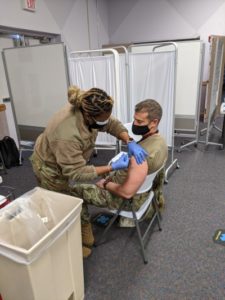WASHINGTON — About one-third of military servicemembers, civilian contractors and military family members are declining to be vaccinated for COVID-19, and that has DoD officials concerned.
Testifying before the House Armed Services Committee last month, officials estimated that about 359,000 initial doses have been administered and 147,000 people have received the needed second dose. However, vaccine refusal has mirrored the civilian sector, with many opting out of vaccination due to concerns about the safety of the drugs.
“We believe the vaccine is the right thing to do. It’s clearly safe for servicemembers,” testified Air Force Maj. Gen. Jeff Taliaferro, vice director for operations for the Joint Chiefs of Staff. “We need to continue to educate our force and help them understand the benefits and ensure there’s leadership involvement in discussion of the benefits of the vaccine. … Our initial look, and this is very early data, [is that] acceptance rates are somewhere in the two-thirds territory.”
DoD cannot mandate that anyone become vaccinated due to existing federal regulations. The Common Rule, implemented in 1981, set rules for federal agencies regarding the use of experimental drugs. Namely, it mandated that individuals could not be asked to participate in drug research without their informed consent.
One of the reasons the Common Rule was created was the government-run Tuskegee Syphilis study. The study looked at the effects of syphilis on Black men in Tuskegee, AL, from 1932 to 1972. It was later discovered that the study subjects were never informed about the purpose of the study, and those with syphilis were not given proper treatment.
When it comes to the military, the Common Rule was further strengthened by a 1998 law that prohibits the services from mandating any drug that has not been fully approved by the Food and Drug Administration. This includes drugs approved under an emergency use authorization (EUA) as well as medications being used for nonapproved uses. The 1998 law stemmed from concerns by servicemembers around the use of an anthrax vaccine to prevent inhalational anthrax and its possible connection to Gulf War Syndrome. The FDA had approved the drug for cutaneous infection, not inhalational anthrax.

The 926th Wing distributes the second dose of COVID-19 vaccines in February at Nellis Air Force Base, NV. The DoD is concerned that so many servicemembers and family members are turning down the opportunity to be vaccinated. Photo by Staff Sgt. Paige Yenke.
Because the current COVID-19 vaccines have all been approved by using an EUA, they fall under that restriction, and DoD cannot mandate their use.
A straw poll conducted in December by Blue Star Families, a military advocacy group, found that nearly half of active-duty servicemembers (49%) said they did not plan to get the COVID-19 vaccine, citing “safety concerns and suspicions over development.” That number rose when it came to the spouses of active duty personnel, with 54% saying they would not get the vaccine.
According to the survey, 28% of respondents didn’t consider COVID-19 to be a threat.
DoD officials told legislators that they hope continued education will decrease the numbers of those refusing a vaccine.
“I think we’re in the beginning phases of this vaccine,” explained Robert Salesses, assistant secretary of defense. “I think the opportunity to educate will reduce [refusals] significantly.”
DoD officials did not turn down the offer of legislative support to change the law, however, and pave the way for mandating EUA-approved vaccines in the future.
Rep. Trent Kelly (R-MS) posed the question as to whether it would be useful for Congress to allow DoD to mandate medications on a case-by-case basis.
“I’m not just talking about this pandemic, but the next one and the next one,” Kelly explained. Gen. Paul Friedrichs, MD, the joint staff surgeon, told Kelly, “Speaking as a physician, it’s always helpful to partner with you and our colleagues at the CDC and HHS to craft language that allows us to respond to a pandemic or biological threat as it occurs. They will each be different. It will be difficult to write language to cover everything, but we look forward to working with you on that.”
Officials also spoke to DoD’s participation in the civilian response to the pandemic, including early stumbles such as the deployment of the USNS MERCY to New York City in March 2020, when that city became the epicenter of the virus in the United States. While the hospital ship had been sent to the city ostensibly to act as a site for patient overflow, very few physicians or hospitals took DoD up on the offer.
According to Taliaferro, this was the result of DoD not yet understanding what resources would be the most useful to civilian hospital centers.
“Most of our fielded medical capabilities are designed to deploy to a wartime environment and do trauma care. That does not make them perfectly equipped for disease control as is needed during the pandemic. As we utilized some of these traditional field and medical capabilities, we found it much more useful to deploy our personnel to existing infrastructure, whether that be existing hospitals or medical centers,” Taliaferro explained. “Largely we found that those hospitals and centers were not short on physical capacity; they were short on staff. With the addition of DoD personnel to expand their internal capacity, it allowed our personnel to be much more effective in their response. That was an evolution that made our forces much more capable.”
